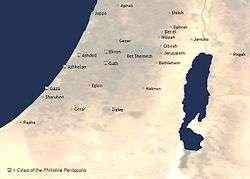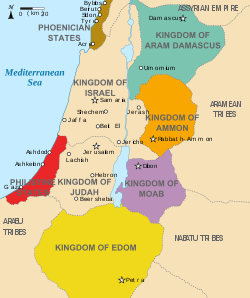Philistia
Philistia (Hebrew: פלשת, Pleshet) was a geo-political region occupied by the Philistines. Its northern boundary was the Yarkon River with the Mediterranean Sea on the west, the Kingdom of Judah to the east and the Wadi El-Arish to the south.[1][2] Philistia consisted of the Five Lords of the Philistines, described in the Book of Joshua (Joshua 13:3) and the Books of Samuel (1 Samuel 6:17), comprising Ashkelon, Ashdod, Ekron, Gath, and Gaza, in the south-western Levant.[3]
Philistia (pentapolis) | |||||||||
|---|---|---|---|---|---|---|---|---|---|
| 1175 BC–722 BC | |||||||||
 | |||||||||
| Common languages | Philistine language, Canaanite language, Hebrew language | ||||||||
| Religion | Canaanite religion | ||||||||
| Demonym(s) | Philistine | ||||||||
| Government | Federation | ||||||||
| Historical era | Iron Age | ||||||||
| 1175 BC | |||||||||
• Assyrian conquest of the Levant | 722 BC | ||||||||
| |||||||||
| Today part of | Egypt Israel Palestine | ||||||||
The Five Lords of the Philistines are described in the Hebrew Bible as being in constant struggle and interaction with the neighbouring Israelites, Canaanites and Egyptians, being gradually absorbed into the Canaanite culture.[4]
The Philistines were no longer mentioned following the conquest of the Levant by the Neo-Assyrian Empire (911–605 BC). Genetic and archeological evidence suggest that the Philistines immigrated from Southern Europe to Canaan, and mixed with the native Canaanites during the first couple of centuries.[5]
East of Gaza

The area east of Gaza, particularly around Nahal Besor that reaches into the hills as far as Beersheva had a very substantial Philistine presence. This area is a part of the Negev desert. It also includes Nahal Gerar to the north that joins Nahal Besor before flowing into the Mediterranean Sea.[6]
This was a heavily populated area during the early Iron Age. It includes archaeological sites such as Tell Beit Mirsim, Tel Haror, Tel Sera (Ziklag) along Nahal Gerar, and Tell Jemmeh and Tell el-Farah (South) along Nahal Besor.[7] All these sites and others in the area had Philistine settlements.[8]
When the Neo-Assyrian Empire first invaded this area, the Philistine cities were given considerable autonomy in exchange for tribute. But having responded to various revolts, this policy hardened.[9]
Kings
- Achish the king of Gath
See also
- Palistin (or Walistin), a Syro-Hittite kingdom (11th–9th c. BC) in what is now NW Syria and the SE Turkish province of Hatay
References
- Ehrlich, Carl S. (1996). The Philistines in Transition: A History from Ca. 1000-730 B.C.E. BRILL. p. 3. ISBN 9789004104266. Retrieved 18 February 2019.
- Ben-Shlomo, David (2010). Philistine Iconography: A Wealth of Style and Symbolism (PDF). Saint-Paul. p. 14. ISBN 9783525543603. Retrieved 18 February 2019.
- Note - the "Lords" is a translation of seren or ceren (סַרְנֵ֣י) in Hebrew, or satrap (σατραπείαις) in the Greek of the Septuagint
- Library, National Public. "Philistia | National Public Library - eBooks | Read eBooks online". nationalpubliclibrary.info. Retrieved 2016-11-01.
- "Biblical Philistines—archenemies of ancient Israelites—hailed from Europe, DNA reveals". 2019-07-02.
- David Ben-Shlomo, Tell Jemmeh, Philistia and the Neo-Assyrian Empire during the Late Iron Age. Levant 2014; 46(1), 58-88 doi:10.1179/0075891413Z.00000000031
- Gunnar Lehmann, Steven A. Rosen, Angelika Berlejung, Bat-Ami Neumeier and Hermann M. Niemann, Excavations at Qubur al-Walaydah, 2007–2009 academia.edu
- "Tell el-Far'ah, South -- Israel Excavation Project Website". Farahsouth.cgu.edu. Retrieved 12 Jan 2016.
- David Ben-Shlomo, Tell Jemmeh, Philistia and the Neo-Assyrian Empire during the Late Iron Age. Levant 2014; 46(1), 58-88 doi:10.1179/0075891413Z.00000000031